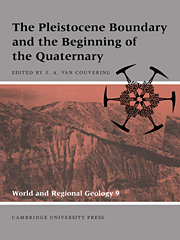Book contents
- Frontmatter
- Contents
- List of contributors
- Preface: the new Pleistocene
- Foreword
- Part I Definition of the base of the Quaternary
- Part II Characterization of the Pleistocene boundary-stratotype
- Part III The paleontological context of the Pleistocene boundary
- 7 The Pliocene–Pleistocene boundary in deep-sea sediments
- 8 Late Cenozoic changes of flora in extra-tropical Eurasia in the light of paleomagnetic stratigraphy
- 9 Plio–Pleistocene mammal faunas: an overview
- 10 Human evolution in the Plio–Pleistocene interval
- Part IV The Pleistocene boundary in regional sequences
- Index
8 - Late Cenozoic changes of flora in extra-tropical Eurasia in the light of paleomagnetic stratigraphy
Published online by Cambridge University Press: 10 November 2009
- Frontmatter
- Contents
- List of contributors
- Preface: the new Pleistocene
- Foreword
- Part I Definition of the base of the Quaternary
- Part II Characterization of the Pleistocene boundary-stratotype
- Part III The paleontological context of the Pleistocene boundary
- 7 The Pliocene–Pleistocene boundary in deep-sea sediments
- 8 Late Cenozoic changes of flora in extra-tropical Eurasia in the light of paleomagnetic stratigraphy
- 9 Plio–Pleistocene mammal faunas: an overview
- 10 Human evolution in the Plio–Pleistocene interval
- Part IV The Pleistocene boundary in regional sequences
- Index
Summary
Introduction
Most studies of the problem of stratigraphic resolution in the transition zone between the Pliocene and the Pleistocene have been based on geology, mammals, malacofauna, or marine microfauna. Paleobotany has been used to a much lesser extent, and mainly for interpretation of the vegetational changes resulting from continental glaciations. Good examples of this approach are the studies of Sue and Zagwijn (1983) and Lona and Bertoldi (1973). Both in those studies and in the majority of others, evolution of flora has been considered on a quite limited scale and as a rule has concerned only evolutionary sequences in the development of individual species (mainly of water plants and bog plants). Such studies seldom have been concerned with overall changes in regional floras.
The paleobotanic data on the deposits of the late Cenozoic period show, quite reliably, that the flora of the Neogene system, which was of a subtropical character, was considerably richer than that of the Quaternary. The latter, in the whole extra-tropical space of the Northern Hemisphere, had the properties of a temperate-type flora. That gives us grounds to believe that studies of the processes by which floristic types change may yield quite important insights into stratigraphic problems at the border between the Neogene and the Quaternary.
Unfortunately, a detailed characterization of the successive paleofloras of the late Cenozoic period is possible, at present, in only a few well-studied regions. There is, however, one circumstance that can greatly help in obtaining the data necessary for such an investigation. During the late Cenozoic period, the vegetation cover over the greater part of extra-tropical Eurasia was clearly of forest character.
- Type
- Chapter
- Information
- The Pleistocene Boundary and the Beginning of the Quaternary , pp. 104 - 113Publisher: Cambridge University PressPrint publication year: 1996
- 2
- Cited by



